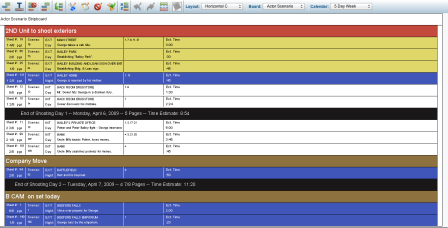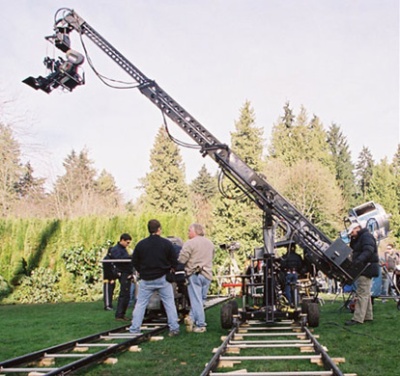
Now that digital has more or less caught up to shooting on film, though some purists will still argue that digital isn’t quite there yet and that film looks better, we see many of the constraints of working with film gone, only to be replaced with problems of a new sort.
Exhausting the actors.

When mags of film would roll out and require a reload, directors were forced to better plan what they wanted and then do their best to capture it efficiently. Unless you were a big production, the cost of film alone prevented doing massively long takes and shooting a dozen different angles just to have more to play with in the edit. Indecisiveness and lack of clear vision was shunned. Unfortunately now with the leeway of digital, we see dozens of takes from a multitude of angles as clarity of vision is often replaced with a wing-it “let’s try this” approach. Actors love to get to try different things, and many times that produces pure gold, but when this new flexibility is abused, actors can get worn down. An entire day shooting a 3 page scene over and over and over would tire even the most seasoned actor, and performances start to drop off. Then there’s crew. They get far less turnaround between days than actors do (9 hours on stage and 10 hours on location, including drive time home and back to work the next day… Teamsters only get 8) and safety and productivity can suffer greatly as your crew wears out. 
Running up the budget.
Another problem stemming from the overshooting/underplanning issue is one directors often ignore, but one that keeps producers awake at night. Budget.

Paying an entire crew for those extra few hours tacked on to each day because of a less constrained process can cost tens of thousands of dollars an hour. IATSE film crews get time and a half after 8 hours, which they almost always go past. Once you pass 12 hours your crew goes into double-time. If you go long, you’ve essentially hired an entire second crew (money-wise) for each hour you go over, yet you still get the output of one crew, and that’s an increasingly tired crew at that. Then factor in meal penalties (a union crew must be broken for meals every 6 hours, otherwise they are paid a penalty every half hour, which can really add up) and costs skyrocket. One way to avoid running long is by tacking on additional days to keep the overtime low, but we’ve seen in countless times, if you give an extra few days leeway, the 10 hour days will still often creep up to 14 or 16 hours, and now you’ll just have more of those overtime days rather than actually cutting costs. Adult Supervision (i.e. a producer with balls to stand up to the director when need be) is vital on a set where money is an issue.
 If you’re shooting on location, you may have to pay the location, neighbors, traffic control, security, rental bathrooms, and other equipment for extended hours as well. Long story short(ish), if you don’t rein in your director the budget can go out the window.
If you’re shooting on location, you may have to pay the location, neighbors, traffic control, security, rental bathrooms, and other equipment for extended hours as well. Long story short(ish), if you don’t rein in your director the budget can go out the window.
Those poor editors.
I worked a project recently that shot back-to-back takes of 38 minutes and 42 minutes with two cameras operating. That’s 160 minutes of footage shot in 80 minutes of work. These were unusually long takes, but are indicative of what can happen when a director goes off-book. The five most dangerous words in Hollywood are, “Hey, I have an idea.”

If a director shoots with two cameras and averages three 10 minute takes per setup, then shoots sixteen setups per day on a 30 day shoot, you’re looking at (roughly) 16 hours of footage a day, or 480 hours of footage at the end of 30 days. That’s a month of non-stop viewing on an 18 hour day schedule, not including the actual act of editing.
Now consider that continuous rolls means no slate to break up the action and mark a moment. Unless the director is very good at telling the script supervisor which moments they really like on the fly as they happen, the director and editor will later have to re-watch all that footage to find what they want to use, searching for that needle in a haystack. Amusingly I’ve heard from several editors that almost always in this situation the director will use the first take that they come across that they like, even if there may have been something amazing further down the line. 
I love digital. I believe digital opens up many opportunities to be creative and efficient, but it is also important to not allow the benefits of shooting digital be erased by poor filming practices. Directors need adult supervision to keep them from shooting 2 hours of insert shots of hands from 7 different angles. I’ve seen a director (who happened to be the showrunner, so he got away with it) shoot multiple masters from different angles. The guy had so little clue how to shoot or what he wanted, he was just getting a master, then closer, then closer, then closer from every angle.  It was a shit-show and the actors (not to their head honcho’s face of course) were even breaking composure and bitching about it.
It was a shit-show and the actors (not to their head honcho’s face of course) were even breaking composure and bitching about it.
Use digital as the amazing tool it is, but plan ahead and use it well. If you treat digital like film and follow at least some of the same production practices (for the most part, after all, flexibility of digital is a big plus) then you should still be quite able to shoot excellent material at a much lower cost in terms of money, time, and frustration, than film.
Lastly, Always Remember the 5 P’s:
















